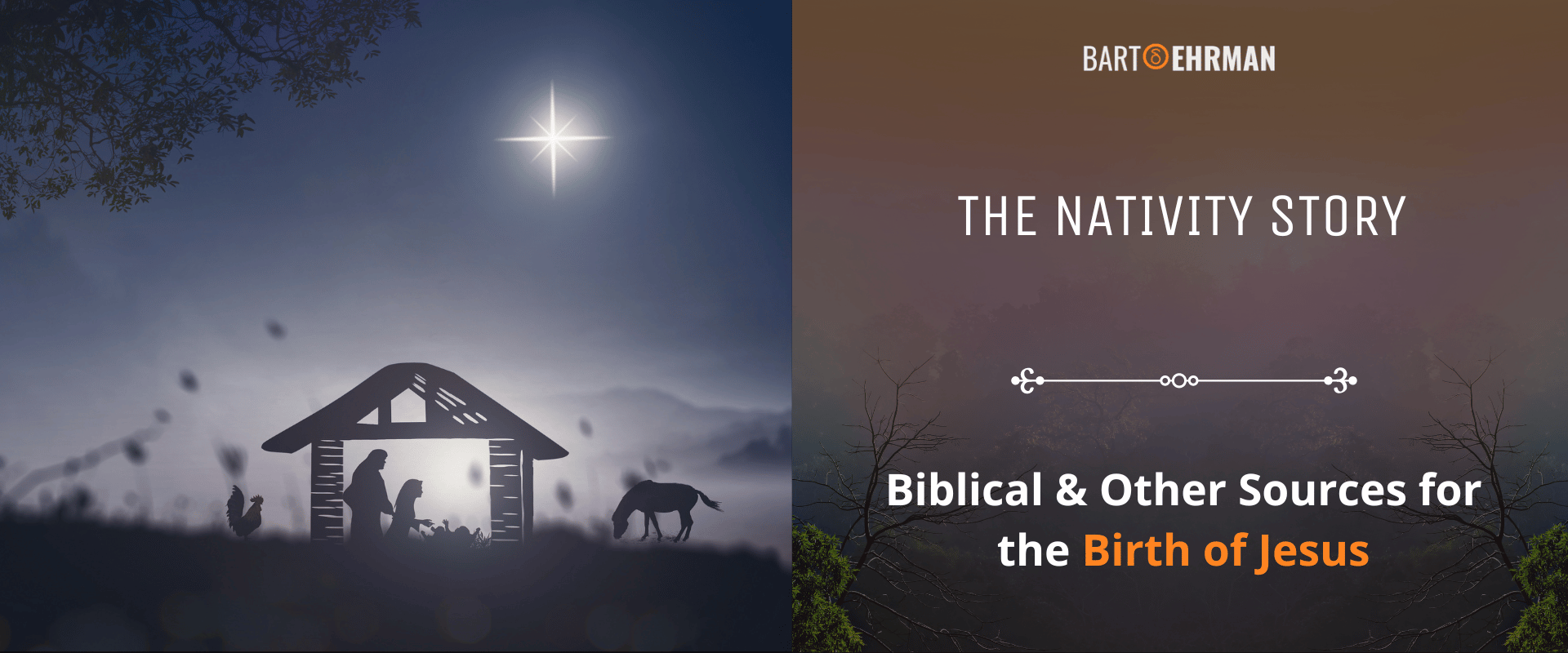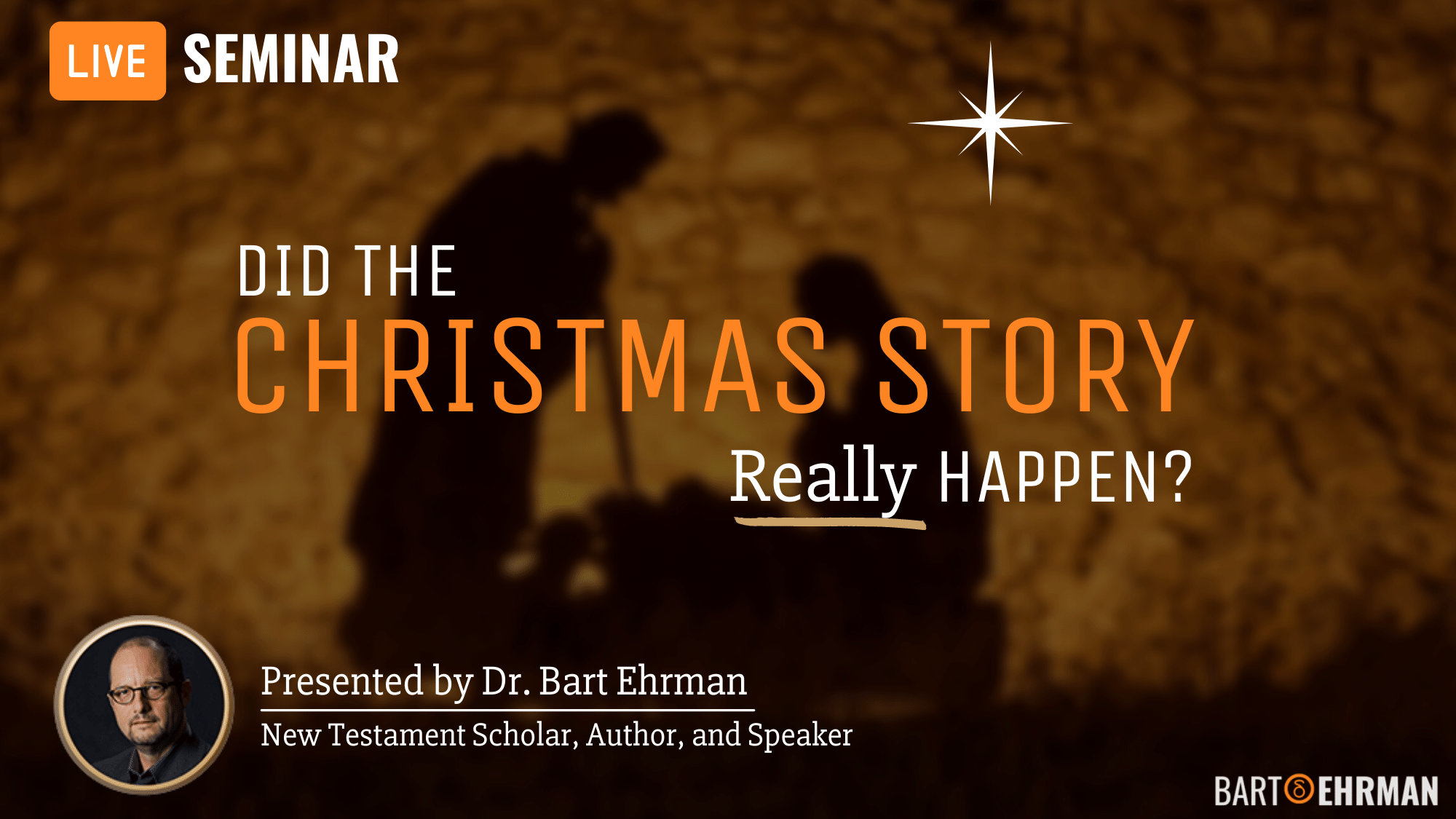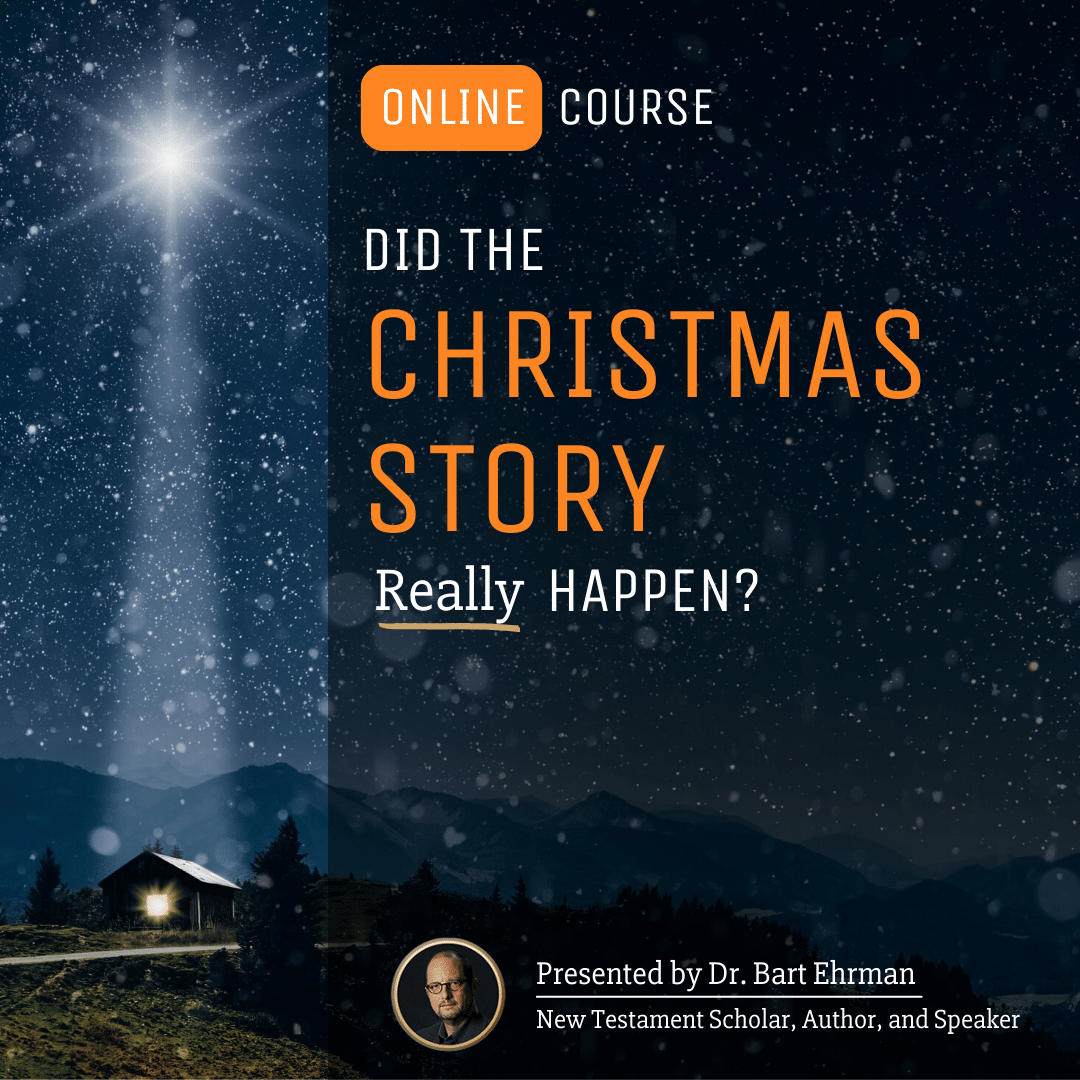The Nativity Story: Biblical & Other Sources for the Birth of Jesus

Written by Marko Marina, Ph.D.
Author | Historian
Author | Historian | BE Contributor
Verified! See our guidelines
Verified! See our editorial guidelines
Date written: December 12th, 2023
Edited by Laura Robinson, Ph.D.
Disclaimer: The views and opinions expressed in this article belong to the author and do not necessarily match my own. - Dr. Bart D. Ehrman
Christmas is here again, and all over the globe, folks are getting into the holiday mood. You see nativity scenes everywhere, showing that peaceful scene of baby Jesus being born. It’s the perfect time to explore the rich history behind these beloved scenes.
In this exploration, we turn to the Gospels of Matthew and Luke, the primary biblical sources that offer narratives of Jesus' birth, providing foundational yet distinct accounts. These Gospels paint a picture that has profoundly influenced the depiction of the nativity story.
But you may be surprised to learn that some parts of the Christmas story are NOT taken from the Bible.
Beyond the gospel texts lies a fascinating, often less traversed realm of early Christian literature – the apocryphal texts. The term 'apocryphal', derived from the Greek word for 'hidden' or 'secret', traditionally refers to a collection of texts not included in the standard biblical canon.
Among these accounts, one finds captivating elements about the birth of Jesus, which have been seamlessly integrated into the broader fabric of Christmas celebrations. But as historical sources, they offer insights into the cultural and theological milieu of early Christianity, revealing how various communities understood and celebrated Jesus’ birthday.
As a historian of the ancient world, I invite you to join me in exploring these historical visions of Jesus’ nativity story, where history, myth, tradition, and art intertwine to tell a story as captivating as it’s profound.

The Nativity Story in the Bible
There are two stories of Jesus’ birth in the Bible. According to one account, Jesus' birth story unfolds in Bethlehem, a town in Judea. Mary, betrothed to Joseph, miraculously conceives Jesus through the Holy Spirit. Joseph, initially troubled, remains with Mary following divine reassurance in a dream.
After Jesus' birth, wise men from the East, guided by a star, visit Jesus, bringing gifts of gold, frankincense, and myrrh. The family then flees to Egypt to escape King Herod's decree to kill all young male children in Bethlehem and returns to Nazareth in Galilee after Herod's death.
In another account, the nativity story begins with Mary and Joseph living in Nazareth. A decree from Emperor Augustus required everyone to register in their ancestral towns. As descendants of David, Mary and Joseph travel to Bethlehem for this census.
Jesus is born there in a humble setting, laid in a manger because there isn’t room in the inn. Nearby shepherds, informed of this event by angels, visit the baby Jesus. Let’s take a look now at the nature of our sources for Jesus’ birth.
Biblical Sources for the Christmas Story
The best historical documents we have about Jesus’ life come from Paul and the canonical gospels - Matthew, Mark, Luke, and John. Paul’s epistles are the earliest New Testament documents. Unfortunately, he doesn’t offer much information about Jesus’ life.
Most historians agree that the Synoptic Gospels (Mark, Matthew, and Luke) generally offer more historical insights into Jesus' life compared to the Gospel of John. This latter text is frequently recognized as the most theologically sophisticated of the four New Testament gospels.
How many of these sources mention the birth of Jesus? As it turns out, Paul, Mark, and John don’t refer to Jesus’ birthday at all. The author of Mark’s Gospel simply starts his narrative with a clear proclamation of the beginning of Jesus’ public ministry: “The beginning of the good news about Jesus the Messiah, the Son of God (1:1).”
Why is that the case?
How do we explain Mark’s omission of Jesus’ birth? Most scholars believe that the earliest traditions of Jesus’ life were concentrated on his death and resurrection. To put it more bluntly, Mark likely didn’t possess any information about the nativity story.
As Raymond Brown explains in The Birth of the Messiah: “The oldest Christian preaching about Jesus concerned his death and resurrection… The preaching was eventually shaped into an account of the passion which constituted the oldest consecutive narrative about Jesus.”
Only Matthew and Luke give us details about Jesus’ birth. However, many scholars doubt their historical accuracy as they contain several apparent contradictions and historical improbabilities. In Luke's account, we find Jesus’ family residing in Nazareth, compelling the author of Luke to devise a narrative device — the census — to transition them to Bethlehem for the birth of Jesus.
Contrastingly, in Matthew's version, Bethlehem is already home to the Holy Family. Here, the evangelist's challenge lies in narrating their subsequent move to Galilee - a journey he explains through the harrowing events of Herod's massacre of infants and the ruthless reign of his son Archelaus.
In any case, these two accounts provided the earliest depictions of Jesus’ birth but they don’t give us much information.
Check out the few details provided by Matthew and Luke in the table below.
Aspect | Gospel of Matthew | Gospel of Luke |
|---|---|---|
Birthplace | Bethlehem (Judea) | Bethlehem (Judea) |
Joseph’s and Mary’s hometown | Bethlehem (Judea) | Nazareth (Galilee) |
The exact location of the Birth | Not explicitly mentioned | In a manger |
Visitors | Magi (unknown number) | Shepherds (unknown number) |
Gifts | Gold, frankincense, myrrh | No gifts mentioned |
Animals | Not mentioned | Not mentioned |
Age of Joseph | Not mentioned | Not mentioned |
The Birth of Jesus: Exploring Differences, Places, and Dates
The subtle yet significant differences between Matthew’s and Luke’s accounts of the nativity story reflect the distinct communities and theological intentions behind each text.
Matthew’s gospel, for instance, is keenly aware of its Jewish audience. It frequently references Old Testament prophecies and firmly situates Jesus’ birth as the fulfillment of these ancient predictions. This perspective is evident in the genealogy presented in Matthew which links Jesus to David and Abraham - key figures in Jewish history.
Luke’s account, on the other hand, appears to address a broader, more diverse audience. His narrative is more inclusive, highlighting the universal significance of Jesus’ birth. Luke’s emphasis on the shepherds who were considered to be at the margin of society and the manger scene symbolizes that the good news is open to all - regardless of social status.
Furthermore, Luke’s detailed account of the census underpins a historical anchoring of Jesus’ nativity thus situating his birth within the broader context of Roman rule and governance.
Where was Jesus born? Despite the popular belief based on the tradition of the Church, Jesus was probably born in Nazareth, not Bethlehem. Most scholars, including Bart Ehrman, would agree! Check out our earlier article and find out more about the place of Jesus’ birth!
What about the exact year of the birth of Jesus? Can we determine the date behind the birth of Jesus and the nativity story?
Both gospels agree on the location of Jesus’ birth: Bethlehem. Unfortunately, they don’t give us an answer to the question of when Jesus was born. Some conservative authors tried to argue that Jesus' nativity scene should be set in the Fall based on shepherds guarding sheep.
However, these are highly unlikely speculations that never found any acceptance among critical scholars. In other words, there is no secure date or year of Jesus’ birth. All we can do is make broad suggestions.
Historians, therefore, usually pinpoint Jesus’ birth around the reign of Herod the Great who died in 4 B.C.E. Furthermore, both Matthew and Luke assume that Jesus was an infant during Herod’s reign.
Consequently, Bart Ehrman notes in Jesus: Apocalyptic Prophet of the New Millennium that Jesus’ birth couldn’t happen later than 4 B.C.E. Majority of historians conclude that Jesus was born between 6 and 4 B.C.E.
For early Christians, of course, the theological significance of the birth of Jesus overshadowed the need for precise historical dating. For us historians, this is akin to being handed a detective novel with the final pages torn out. It's a bit of a letdown, but on the bright side, it keeps our research lively and our debates even livelier!
But, wait a minute! What about all those classic paintings of Jesus’ birth in the cave? Wasn’t Joseph much older when Jesus was born? Weren't there a donkey and an ox in the cave with Jesus?
This may come to you as a surprise, but these widely held ideas are nowhere to be found in the Bible. They are derived from the early Christian texts that never made it into the New Testament! These texts are usually designated as the Early Christian Apocrypha.
How much of the Christmas story is based on the actual events? If you want to know the scholarly answer to this question, join Bart Ehrman’s captivating course “Did the Christmas Story Really Happen?” Explore the earliest Christian sources with a renowned historian and travel back to the origins of Christianity!
Another Source for the Nativity Story
The Early Christian Apocrypha have a reputation for being heretical or even gnostic. To be honest, many of them, from the perspective of mainstream Christianity, are within these categories. However, others don’t contain any heretical doctrines at all. What sets these writings apart is the fact they weren’t, for various reasons, accepted as canonical.
One of those documents is the so-called Proto-Gospel of James which probably originated in the late 2nd century. Soon it became hugely popular - especially among the Christians in the eastern Mediterranean world.
In The Other Gospels, Bart Ehrman and Zlatko Plese note: “Of all the Early Christian Apocrypha, none played a larger role in the theology, culture, and popular imagination of late antiquity and the Middle Ages than the Proto-Gospel of James.”
The Proto-Gospel of James never achieved the same level of popularity in the Western part of the Christian world. The reason for that was Saint Jerome - a powerful proponent of the holiness of asceticism and virginity. He didn’t like the gospel because it taught that Joseph had sex with his first wife with whom he had children. Jerome, however, believed that such a saintly man lived a celibate life. He, therefore, concluded that the siblings of Jesus mentioned in the New Testament were his cousins, not the children of Joseph.
Before we delve into Jesus’ nativity story as depicted in the Proto-Gospel of James, it’s important to note several key facts. Composed in the late 2nd century, this text emerged during a period of burgeoning theological diversity within early Christianity.
To put it more bluntly, the Proto-Gospel of James reflects an era when the boundaries of the New Testament weren’t yet firmly established which allowed a flourishing of diverse narratives and interpretations of Jesus’ life.
Its popularity underscores a keen interest of the early Christians in the more intimate aspects of Jesus’ family - aspects that weren’t elaborately covered in the canonical texts. This apocryphal gospel not only satisfied the curiosity of early Christians about Mary and Joseph but also played
a pivotal role in shaping our collective memory of Jesus’ nativity story and the doctrine of Mary’s perpetual virginity.
Structurally, the Proto-Gospel of James is notable for its detailed narrative style which contrasts the often terse accounts of the canonical gospels. Furthermore, it employs a vivid storytelling approach, rich in dialogue and descriptive scenes.
Additionally, by providing a backstory to Mary’s life and her divine selection, the text deepens the understanding of her role in Christian theology - especially the doctrine of Mary’s perpetual virginity.
Moreover, the Proto-Gospel of James significantly influenced the artistic representations of Jesus’ nativity thus demonstrating the complex interplay between the Biblical accounts and popular religious piety of the early Christians.
Finally, the author of this account endeavored to reconcile the discrepancies and contradictions present in the accounts of Jesus’ nativity scene in Matthew and Luke.
If one assumes that the strategy of harmonization began with modern conservative scholars, this notion is quickly dispelled. The attempt to integrate these varying narratives dates back to the earliest decades of Christianity!
The Birth of Jesus in the Proto-Gospel of James
At the most basic level, the Proto-Gospel of James filled in the nativity story gaps in the New Testament accounts. Since Luke and Matthew are silent on so many things, early Christians naturally wanted to know more:
To this and other questions, the Proto-Gospel of James gives answers. First of all, it focuses on Mary’s life. It describes her birth to Anna and Joachim; her engagement and marriage to Joseph and her pious and sheltered childhood.
Have you ever wondered if Joseph might be the real father of Jesus? Join us in the fascinating Christmas webinar “Jesus: The Actual Son of Joseph” with esteemed scholar Bart Ehrman. Delve into the intricate narratives of Matthew and Luke, examine often-overlooked passages, and reevaluate long-held beliefs about Jesus' birth.
Furthermore, the proto-Gospel of James depicts Joseph as a widower who was much older than Mary. In this way, it gives us the possible answer to why he never showed up during Jesus’ public ministry: He died before Jesus became a public figure.
Let’s now unpack the depiction of the birth of Jesus in the Proto-Gospel of James.
#1 Setting
The birth of baby Jesus is set in a cave near Bethlehem which represents an expansion on Luke’s account where baby Jesus is said to be laid in the manger. But where was the location of that manger? For the author of the Proto-Gospel of James, Jesus’ birth happened in a cave.
This narrative choice not only adds a mystical element to Jesus’ nativity scene but also resonates with the symbolic use of caves in ancient religious traditions as places of birth and rebirth.
In the Christian context, the cave becomes a symbol of the world’s darkness, out of which the light of Christ emerges. The impact of this portrayal is profound in medieval Christian art where the cave setting becomes a staple in the depictions of Jesus’ birth.
One notable instance is Giotto’s Nativity fresco in the Scrovegni Chapel (Padua, Italy) painted at the beginning of the 14th century. Here, the nativity is set within a rocky cave, with Mary and the infant Jesus at its heart, conveying both the humility and sanctity of the moment.
#2 Joseph’s role
Joseph is portrayed as an elderly widower who is chosen to be Mary’s guardian. At the first news of Mary’s pregnancy, Joseph was troubled and perplexed: “As he came into the house he saw that she was pregnant. Striking his face he cast himself to the ground on sackcloth, weeping bitterly and saying, “How can I look upon the Lord God?”
However, the angel of the Lord appeared to Joseph and assured him that Mary was pure by saying: “Don’t be afraid of this child. For that which is in her comes from the Holy Spirit. She will give birth to a son, and you will name him Jesus. For he will save his people from their sins.”

#3 Miraculous Birth
The actual moment of Jesus’ birth in the Proto-Gospel of James is shrouded in mystery and miracle. As Joseph seeks a midwife, the narrative describes the surroundings becoming still, and when he returns with the midwife, Jesus has already been born miraculously.
This portrayal is significant in early Christian literature as it reinforces the doctrine of the virgin birth. By eliminating the typical physical processes of childbirth, the Proto-Gospel emphasizes Mary's purity and the divine nature of Jesus.
This moment of miraculous birth is not just a theological assertion; it also reflects the early Christian community's endeavor to understand and articulate the mystery of the incarnation.
#4 The Midwife and Salome
The nativity story in the Proto-Gospel of James introduces a midwife and another woman named Salome. The midwife expresses amazement at Mary's virginity even after childbirth. Salome, skeptical of the virgin birth, undergoes a test of faith and is subsequently healed, affirming the miracle of the virgin birth.
Salome’s role in the narrative introduces an element of skepticism - a theme that resonates with the human experience of grappling with the miraculous or the divine. She even demands to physically examine Mary. The Proto-Gospel of James then describes how Salome undergoes a divine punishment for her disbelief, but upon recognizing the miracle she experiences miraculous healing.
The inclusion of Salome as part of Jesus’ nativity story in the Proto-Gospel of James highlights the struggles of early Christians with and ultimate acceptance of the supernatural elements of Jesus’ birth story.
#5 Presence of Animals
Unlike both Matthew and Luke, the Proto-Gospel of James mentions an ox and a donkey being present at the birth. This detail significantly influenced Christian iconography and nativity scenes.
Over time, this imagery of the ox and donkey at the nativity scene evolved, enriched by various legends and interpretations. These animals came to symbolize several theological concepts, such as the representation of both Jews and Gentiles in the Christian religion, indicating a universal message of salvation.
Summing up Conclusion
In concluding our scholarly exploration of early Christian depictions of Jesus’ birth, it becomes evident that our contemporary understandings and portrayals of Jesus’ nativity story are deeply influenced by a blend of historical narratives, traditions, later myths, and cultural interpretations.
The canonical accounts from Matthew and Luke have laid the groundwork, but it’s the Proto-Gospel of James that has left a notable imprint on modern nativity scenes.
This apocryphal text, with its vivid descriptions of Jesus’ birth in a cave, the presence of an ox and a donkey, and the portrayal of Joseph as an elderly widower, has significantly shaped Christian iconography and the popular imagination.
Accounts of Jesus’ birth aren’t just central to Christian traditions but also offer a window into the early Christian mindset for people of all backgrounds, whether they be Christians, Jews, atheists, Muslims, or others. They represent a fascinating aspect of cultural and religious history, reflecting the human desire to understand and contextualize the past.
As a historian of the ancient world, I believe that the objective exploration of these sources reveals the rich world of early Christian storytelling. Furthermore, it unpacks how these ancient narratives continue to influence contemporary perceptions and artistic representations of Jesus’ nativity story.
For those intrigued by the exploration of early Christian texts and their impact on our understanding of Jesus, a further journey awaits!
Renowned biblical scholar Bart Ehrman's eight-lesson course, "Jesus the Secret Messiah - Revealing the Mysteries of the Gospel of Mark," offers an enlightening perspective. Through critical scholarship, Ehrman delves into the Gospel of Mark, uncovering its unique message and portrayal of Jesus.


